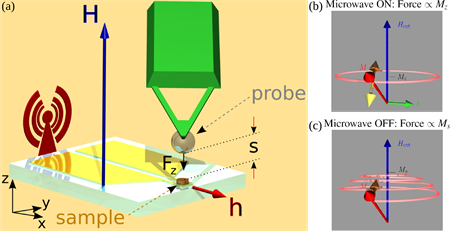Nanomagnetism & Oxides Laboratory
Magnetic Resonance Force Microscopy (MRFM)

Principles of MRFM. (a) Schematics of an MRFM setup. The MRFM probe is dipolarly coupled to the magnetization of the sample, which induces a force Fz on the cantilever. (b) When the microwave field h is turned on, the force on the cantilever is proportional to the longitudinal component of the magnetization Mz . (c) When the microwave is switched off, Mz relaxes back to Ms, its equilibrium value.
Our lab has developed since the early 2000's magnetic resonance force microscopy (MRFM), a near field technique based on magnetic force microscopy (MFM) to detect the spin dynamics at the nanoscale. The main originality of our approach is to use it to probe magnetization dynamics in ferromagnetic nanostructures [1]. A schematics of an MRFM setup is presented in Fig.a. It relies on the dipolar interaction between a magnetic particle attached at the end of a very soft cantilever, which acts as a force sensor, and the magnetization of the sample under study. When the latter undergoes precession, its longitudinal component of magnetization, Mz, is reduced from its equilibrium value Ms (Figs.b and c), which changes the force Fz on the cantilever, thereby inducing a displacement which can be detected optically. In order to gain sensitivity, MRFM experiments are operated in vacuum, which increases the quality factor of the cantilever, and the signal is modulated at the mechanical frequency (a few kHz) of the cantilever. With this amplitude modulation, the MRFM signal is proportional to the static change of longitudinal component of the magnetization induced by the precession, which is directly related to the total number of magnons excited in the sample. The MRFM sensitivity is limited by the thermal noise of the cantilever ; the corresponding spin sensitivity depends on the coupling geometry between the sample and the MRFM probe, that sets the dipolar force between them. Typically, in our experiments, the MRFM probe is a sub-micronic sphere of large magnetization material such as Fe or Co, separated by about 1 to 2 μm from a sub-micronic disk ferromagnetic sample (in other words, the sketch of Fig.a is rouhgly at scale concerning the sample and probe), which results in a spin sensitivity between 100 and 1000 Bohr magnetons in a 1 Hz bandwidth at room temperature.
We have demonstrated that this technique can be used to study the magnetization dynamics in various systems of interest for microwave nanomagnetism, such as magnetic vortices [2], spin torque oscillators [3], and dipolarly interacting nano-objects [4].
We have demonstrated that this technique can be used to study the magnetization dynamics in various systems of interest for microwave nanomagnetism, such as magnetic vortices [2], spin torque oscillators [3], and dipolarly interacting nano-objects [4].